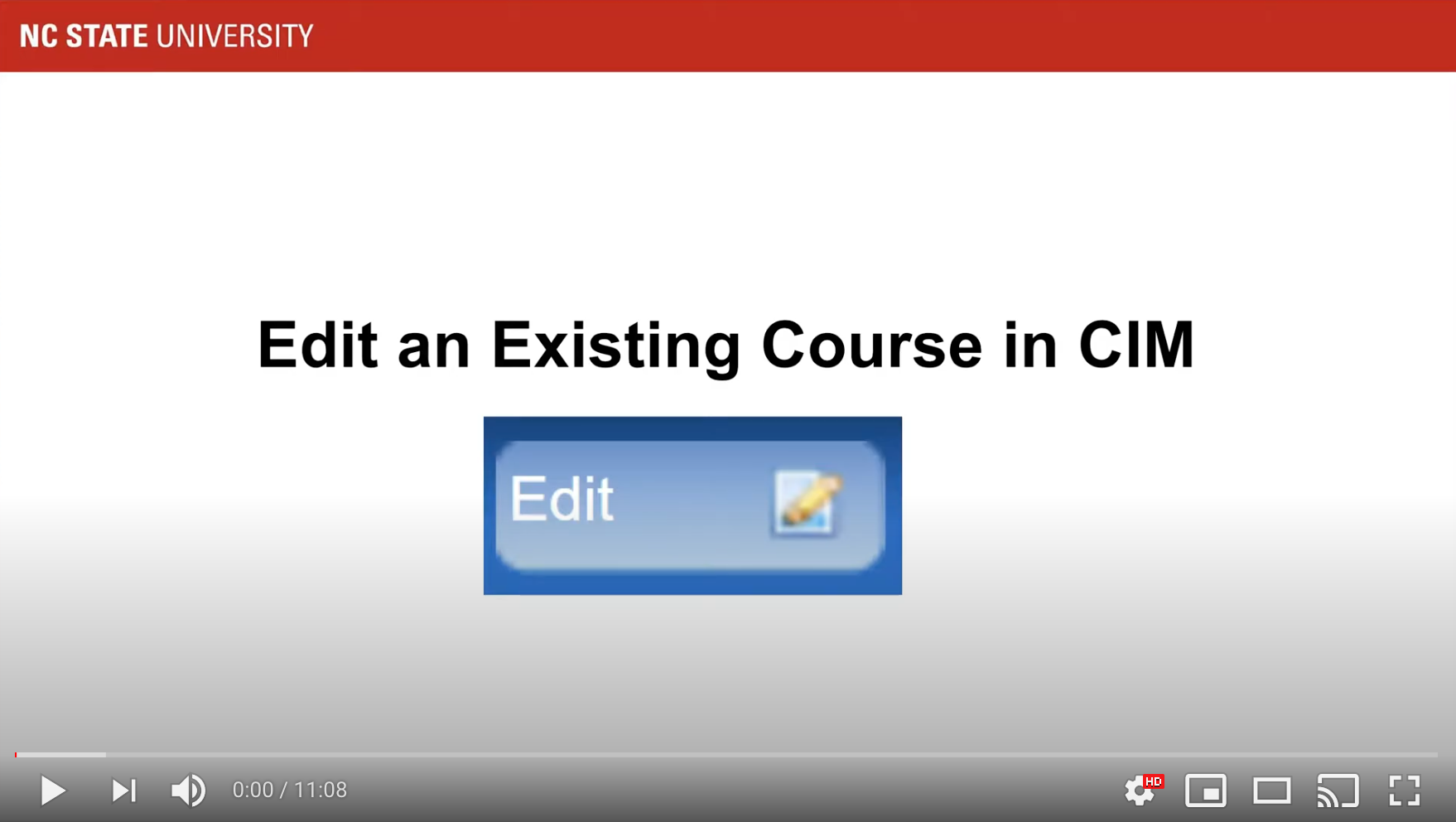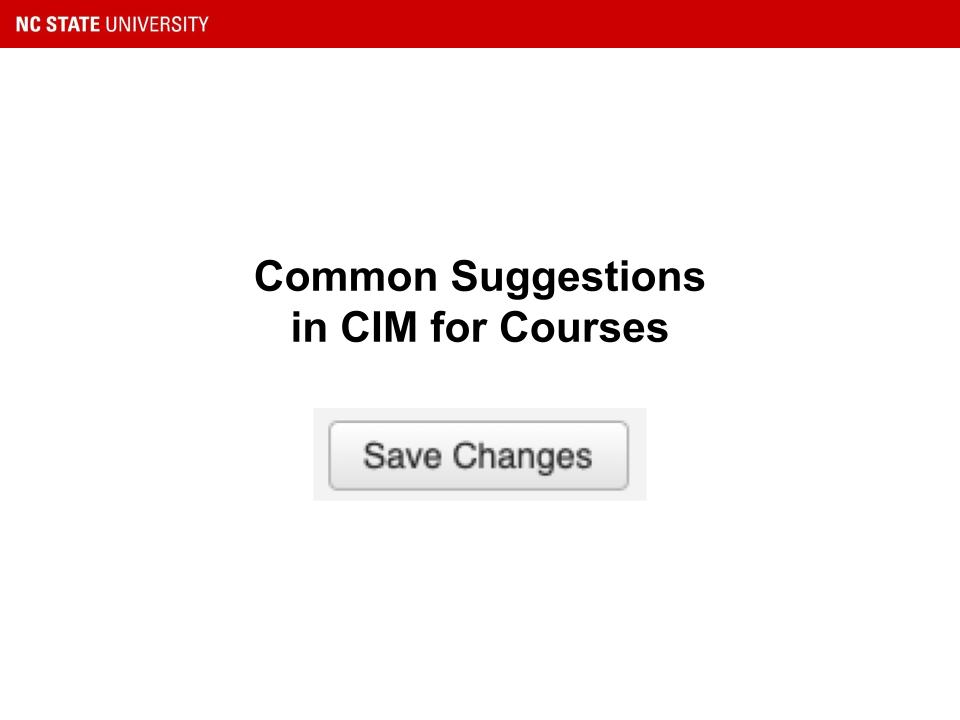CIM for Courses
Course Inventory Management Guides
NC State uses the Course Inventory Management (CIM) system for all course actions. There are two websites, one, to initiate actions and search and the other to review and approve actions. Additional Course Assistance and Guidelines are below.
Note: If you’re signing in off-campus, make sure to use the NCSU VPN.
Quick Guide to Editing a Course in CIM
CIM for Courses: https://next-catalog.ncsu.edu/courseadmin/
Is your change possibly “administrative?” Check for definitions and process here.
Course Assistance and Guidelines
Please visit the Credit/Contact Hour Guidelines to review the types of components (Lab, Lecture, Fieldwork, Internship) as a guide for organizing your course structure.
Information on course numbering and cross/dual-listing your course is available in Course Information.
Information on course attributes and the meaning of years “typically offered” can be found in the Scheduling page Attributes.
A read-through of the syllabus regulation with guiding questions and resources is available on Syllabi for Faculty.
Planning to make a new internship, special topics, or research course? There is specialized guidance from UCCC on building these course records in Specialized Courses.
GEP information can be found on the link to the General Education Program.
Student Evaluation Methods
Student evaluation methods form an important part of department, college, and university-level reviews at NC State. While the college and department review includes information in the syllabus, the University Courses and Curricula Committee only uses the CIM for Courses record in its review.
Student evaluation methods reflect the design intent of a course – how its outcomes are reinforced and assessed – as well as the alignment of course design with course level, with higher-level courses generally including more complex tasks. Review of both of these aspects factors into supporting a course in the creation of its record, and also provides evidence of faculty governance in accordance with accreditation standards.
CIM for Courses records capture information that is applicable to all course offerings. Providing ranges in select CIM fields, such as the student evaluation methods, helps to illustrate in the course record the range of methods used in the course design and can also help to ‘future proof’ the CIM record for future offerings. Keep in mind that these can still be changed in the future as the course evolves.
Remember that any ranges should reflect a balance of flexibility and course design and show intentionality.
How to Use the Field in CIM Courses:
- Choose the evaluation method that best fits your plan from the dropdown
- Write the weight or range that this component presents (i.e. if there are two exams and they can reflect about 10-15% of the total grade, enter 20-30%)
- Add any additional information in the “Additional Information” field at the bottom of the form
- If none of the options reflect your desired evaluation method, choose “Other” and write a description of your evaluation method in the “Additional Information” field at the bottom of the form
Tips for Using Ranges:
- If a method may not be taught for every offering, start the range at zero. (IE: Discussion 0-10%)
- If a method will definitely be used in every offering start with the minimum percentage to the maximum. (IE: Written Assignments 25-50%)
- For dual level (400/500 level) courses include both undergrad and graduate percentages in the percentage field. (IE: Undergrad 20-30%, Graduate 30-100%)
- Ensure that your ranges can add up to 100% between the minimums and maximums of your ranges
- If the total of the minimums equals 100%, the higher numbers of the ranges cannot be used as they would exceed 100%.
- If the total of the maximums equals 100%, the lower numbers of the ranges cannot be used as they would not add up to 100%.
- Ranges should reflect possible uses of minimums and maximums, and the likely implementation of an offering of the course will frequently find its 100% between those ranges.
Collaborative Assessment Methods
To continue to support and properly review courses using various forms of collaborative assessment (such as: ungraded, contract graded, specifications grading) and courses with other innovative/non-traditional methods of grading coming through university-level reviews, UCCC has established the following expectations and clarification for entering courses into the CIM Courses system. Courses that reach the university-level steps as of Fall 2024 will be expected to meet these standards.
CIM System Now
- Expectations regarding student evaluation and final grading should remain a part of the syllabus and falls under departmental and college review processes.
- Student Evaluation Methods should be listed in the CIM for Courses record.
- In a course with traditional grading, specific evaluation methods should be listed with the percentage weight for each. Ranges are recommended as a best practice to allow flexibility for future course offerings.
- In a course with collaborative assessment, evaluation methods should be listed. As appropriate to the type of assessment employed (contract, specifications, ungraded, etc.) list any ranges, “ungraded”, or information that is relevant for each evaluation method.
- This may include ranges reflecting the amount of time spent, terms such as “formative” and “summative,” and/or could include “ungraded” or otherwise.
- The instructor can use the notes section to clarify evaluation methods further as needed.
CIM System Future
- We will be investigating the possibility of “if – then” logic in the new CIM for Courses implementation. Please stay tuned for first-looks and updates.



